Dr. Yves Moussallam
Postdoctoral Researcher, University of Cambridge, U.K.
Team Leader - "Man with a plan"
Team leader Yves has extensive experience planning and running expeditions on active volcanic systems. Yves is also the team medical officer, a role he previously assumed in past expeditions including an Antarctic field season. Yves’ previous expeditions have taken him to Indonesia, Chile, Costa Rica, Ethiopia, Slovakia, Sicily, Iceland, Antarctica and Far North Canada.
Yves’ research focuses on understanding magmatic degassing from the mantle source to the surface. He studies the effect of degassing of volatile species on melt chemistry, molecular structure, and transport properties. Understanding degassing processes allows interpretation of surface signals (change in the quantity or nature of the gases emitted by volcanoes) and back-calculating information on the mantle source for volatile cycling at the planetary scale. Yves’ time is split between the field where he measures gas emissions using remote and in situ sensing and the laboratory where he experimentally reproduces the high-pressure and high-temperature conditions at which magma forms in the deep Earth.
Dr. Philipson Bani
Chargé de Recherche, IRD, Laboratoire Magmas et Volcans, France
Driver/ Outreach officer/ "Trooper"
Philipson has visited more than 50 different volcanoes in the last ten years, particularly in Indonesia and Vanuatu. He has extended experience with off road driving and expeditions on volcanoes. He provided the first gas measurements on Vanuatu volcanoes and the first estimate of their sulfur contribution to the atmosphere. He is currently exploring volcanic degassing across the Indonesia archipelago (78 active volcanoes).
Philipson believes that any changes in the subsurface reservoir and hydrothermal systems can be reasonably tracked in the degassing dynamic, plume composition, volatiles and thermal emission budget. Thus his research focuses on these latter volcanic manifestations to better constrain and anticipate magma progression to the surface.
João Pedro Lages
PhD Candidate, DiSTeM - Università degli Studi di Palermo, Italy
Volcanologist & Geochemist - "The Rookie"
Joao is a Rookie in expeditions, but has a long record of dreaming and reading about volcanoes. Over the last few years Joao has built a strong and diversified volcanology background through his undergrad and graduate studies and internships at the National Institute of Geophysics and Volcanology (Palermo, Italy) and the Cascades Volcano Observatory (Vancouver, WA, USA).
Joao’s research focuses on the recycling of major Volatiles and Noble gases through arc volcanism. He studies variations in volcanic gas CO2/ST, and the issues related to the compositional heterogeneity of subducted materials from which inaccurate C and S input fluxes in arc trenches arise. A key part of his work is the relation between arc volatile genesis and Noble gases compositional trends, especially 3He/4He, whereby complex mantle and crustal processes can be address problems of petrogenesis, magma degassing, and eruption mechanisms. João is looking forward to joining the joint effort on the TRAIL BY FIRE.
Dr. Nial Peters
Postdoctoral Researcher, University of Cambridge, U.K.
Engineer - Climbing Expert - "Mr Fixit"
Nial had a varied career, including aspects of physics, glaciology, and auroral research, before discovering volcanology. His experience with doing science in the field has taken him to many active volcanoes around the world, including those in Iceland, Sicily, Vanuatu, Costa Rica, Chile, and especially - Antarctica.
Nial is passionate about the development of new technology for facilitating research. He is part volcanologist and part electrical engineer, continually inventing and applying new systems such as portable radar instruments, geothermal energy harvesting tools, and thermal imaging instruments. Nial is the critical, "Mr. Fixit" of the Trail by Fire team. He never leaves home without a soldering iron. He can fix anything in under 5 minutes. He can build a spectrometer with some chewing gum and a bit of fishing line.
Drone (UAV) Specialist - "Tony Stark"
Aaron has extensive experience performing geophysical and geochemical investigations and has worked on volcanoes in Ecuador, Chile, the USA, but the majority of his research has been in the fumarolic ice caves of Mt. Erebus, Antarctica. He has worked at Los Alamos National Labs developing and piloting remotely operated drones as a faculty guest researcher, and has piloted multirotor drones over active vents at Villarrica volcano, Erebus volcano, and Cotopaxi volcano.
Aaron is passionate about the use of new technologies to understand volcanic degassing. He's an expert in fiber-optic distributed temperature sensing, terrestrial laser scanning, thermal imagery, "structure from motion" photogrammetry, infrasound, and drone-based techniques. Aaron has worked with our sponsors and collaborators to assemble a fleet of quadcopters with gas sensing and sampling capabilities, establishing a remote presence in the volcanic plumes we encounter along the Trail by Fire.
Dr. Talfan Barnie
Postdoctoral researcher, The Open University, U.K.
Satellite expert/ Outreach officer/ "Eye from the sky"
Talfan uses satellite images to give wider context to our field measurements over space and time. Talfan’s expertise is in using satellites to monitor remote volcanoes for changes in activity, and his previous expeditions have taken him to Ethiopia, Iceland and Sicily.
Talfan’s research focuses on the use of satellite images to track the behaviour of remote and little understood volcanic systems. Most volcanoes on Earth are unmonitored and we are dependent on distance detection techniques to understand them. By taking images from space at different wavelengths from the ultra violet to the infra red, satellites can be used to detect volcanic gasses, ash emissions and advancing lava flows. Talfan spends his time scouring automated satellite notifications for new eruptions, digging through image archives, building computer models of volcanic processes, and collecting data in the field. For the Trail By Fire expedition, Talfan is working closely with NASA scientists to use satellites to track the team’s progress along the Nazca subduction zone. He will attempt to extrapolate our field observations in space and time, to get a ground tested, synoptic view of volcanic degassing along Andes.








